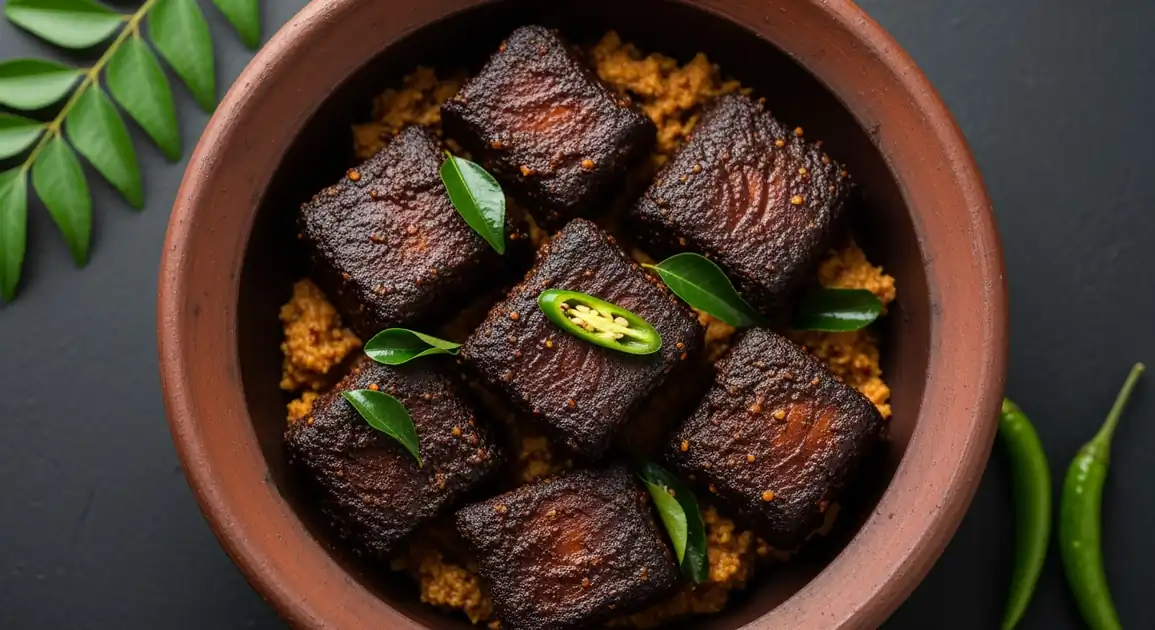Ambulthiyal (Sour Fish Curry)
අම්බුල් තියල්

Description
Ambulthiyal originated in Sri Lanka's southern coastal regions but is now enjoyed throughout the island. While still most authentic in the south, it has become part of the national cuisine and can be found in traditional restaurants across the country. The dish reflects Sri Lanka's resourceful culinary heritage, using goraka's preservative properties to extend the shelf life of fish in tropical conditions.
Dietary Information
Serving information
Serving style
Typically served as part of a rice and curry meal, in a small clay pot or dish, meant to be eaten with rice and other milder curries to balance its intense flavor.
Quick facts
Lunch service typically runs from 12 PM - 3 PM, dinner from 7 PM - 10 PM. Markets and informal eateries may serve earlier, from around 10 AM.
Safety Tips
What to Look For
-
Firm fish pieces that hold their shape
Quality Ambulthiyal should contain solid pieces of fish that flake when pressed but don't disintegrate. Mushy texture indicates poor quality fish or improper preparation.
-
Dark reddish-brown to blackish color
The distinctive color comes from proper use of goraka. Too light a color may indicate insufficient goraka, affecting both flavor and preservative qualities.
-
Fresh, clean aroma with sour notes
Should smell distinctly sour and spiced but not fishy or ammonia-like. The sour smell of goraka is natural, but any off or excessively fishy smells indicate problems.
-
Restaurants that prepare it daily
While Ambulthiyal has natural preservative qualities, freshly made versions are best. Ask when it was prepared if uncertain.
What to avoid
-
Very watery sauce or excessive oil floating on top
Properly prepared Ambulthiyal has a thick, reduced sauce that clings to the fish. Excess liquid may indicate hasty preparation or dilution.
-
Fish with soft, mushy texture or strong fishy smell
These are signs of old or poor quality fish. Despite the preservative nature of the dish, it cannot salvage fish that wasn't fresh to begin with.
-
Bright red color (indicates artificial coloring)
Authentic Ambulthiyal has a dark reddish-brown to blackish hue, never bright red. Artificial coloring is unnecessary in traditional preparation.
-
Version with coconut milk
Traditional Ambulthiyal never contains coconut milk. While not a safety concern, this indicates a non-authentic preparation.
Price information
Price range
Budget tips
- Local 'buth kades' (rice shops) often serve Ambulthiyal at lower prices (600-900 LKR) than tourist restaurants.
- Ordering rice and curry sets that include Ambulthiyal is usually more economical than à la carte.
- Prices increase significantly in upscale restaurants, especially in Colombo (1500-2500 LKR).
- Family-style portions meant for sharing often offer better value than individual servings.
Value indicators
- Large, firm pieces of fish rather than small fragments.
- Deep, complex flavor indicating proper use of spices and goraka.
- Served with rice and complementary side dishes.
- Prepared fresh daily rather than kept for multiple days (despite its preservative nature).
Where to Find This Dish
Southern Province
The dish's birthplace, where the most authentic versions can be found, particularly in coastal towns.
Galle, Matara, Weligama, Mirissa
Lunch, Dinner
Central Markets
Fresh markets in major cities often have food stalls serving traditional dishes including Ambulthiyal.
Pettah Market, Good Market, Manning Market
Morning, Lunch
Traditional Sri Lankan Restaurants
Found throughout the country, especiallythose specializing in authentically Sri Lankan cuisine rather than tourist-oriented establishments.
Kaema Sutra, Upali's, Isso, Mama's Galle Fort Roof Cafe
Lunch, Dinner
Vendor Tips
- Ask when the Ambulthiyal was prepared - even though it preserves well, freshly made is always superior.
- Restaurants near fishing harbors often have the freshest fish for their preparations.
- Look for places where locals eat rather than exclusively tourist-oriented establishments.
How to Order
Regional Variations
-
Tuna Ambulthiyal
(තෝර අම්බුල් තියල්)
The most traditional version made with firm tuna chunks, having the classic dark color and intensely sour flavor.
-
Pork Ambulthiyal
(ඌරු මස් අම්බුල් තියල්)
A non-traditional but increasingly popular variation that applies the same cooking method and goraka paste to pork instead of fish.
-
Ambulthiyal with Green Chilies
(අමු මිරිස් අම්බුල් තියල්)
A spicier variation that incorporates fresh green chilies in addition to the traditional black pepper, creating additional heat.
-
Dry Ambulthiyal
(වියළි අම්බුල් තියල්)
An even more reduced version with almost no sauce, where the fish pieces are intensely flavored and can be eaten almost like a pickle or side dish.
Cultural context
History
Ambulthiyal originated in southern coastal Sri Lanka as a practical preservation method for fish in hot tropical weather before refrigeration was common. The name derives from 'ambul' (sour) and 'thiyal' (fish dish), highlighting its defining characteristic. Fishing communities discovered that goraka, a local dried fruit, not only added distinctive flavor but also acted as a natural preservative, allowing fish to keep longer. This technique permitted fishermen to preserve their catch and transport it inland where fish was less available. Over time, this utilitarian preparation evolved into a beloved culinary specialty now found throughout the country.
Local significance
Ambulthiyal represents Sri Lankan culinary ingenuity, transforming a practical preservation method into a beloved specialty. It showcases the importance of fish in Sri Lankan cuisine and the clever use of local ingredients like goraka.
Eating customs
- Always eaten with rice, never as a standalone dish.
- Traditionally eaten with the right hand, mixing small amounts with rice.
- Often complemented by milder dishes like dhal curry to balance its intensity.